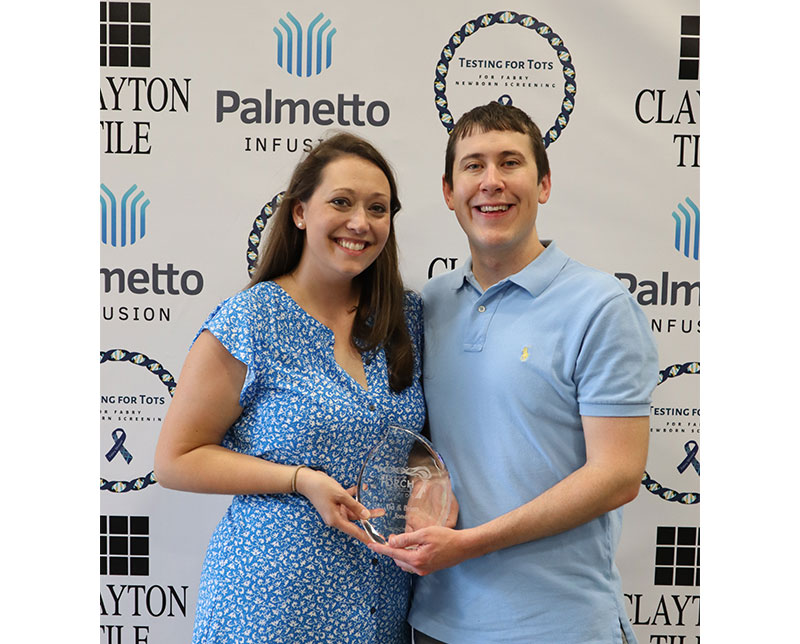Testing for Tots: Fabry Disease Takes National Stage
By Tia Jones, Testing for Tots
My husband Brian and I were in an airport taxi to leave for our honeymoon when he received a call that would change the course of our lives forever. After experiencing unexplained symptoms since early childhood and undergoing countless tests, Brian was officially diagnosed with Fabry disease, a rare genetic metabolic disorder. We were devastated by the diagnosis, but we quickly realized that we could use our experiences to help others impacted by the condition.

Fabry Disease Can Be Difficult to Diagnosis
Fabry disease is caused by a genetic mutation that results in a deficiency of the lysosomal enzyme alpha-Gal A. As a result, a fatty substance builds up in the body, damaging many organs including the heart, kidneys and nervous system. A number of complications can result, including heart abnormalities, chronic pain, strokes, kidney damage, an inability to sweat and gastrointestinal difficulties. The symptoms of Fabry disease are varied and the condition manifests differently in each patient, meaning that many patients wait years before being correctly diagnosed.
Looking back, Brian began feeling the effects of Fabry disease decades before he received his diagnosis. He often missed school beginning in preschool because of gastrointestinal problems that we now know were related to Fabry disease. He underwent two colonoscopies by the time he was 10 years old, but his doctors concluded that he had a simple case of irritable bowel syndrome (IBS).
As Brian got older, his symptoms became more severe and puzzling. By the time he was in medical school, he was experiencing hearing loss, kidney damage, heat intolerance and worsening neuropathy in his feet. He suspected that he might have diabetes, but his blood sugar testing came back normal. It wasn't until he saw a sentence about Fabry disease on a slide deck during a medical school lecture that he learned about the condition he would eventually be diagnosed with.
Coping with Fabry Disease as a Family
When someone is diagnosed with Fabry disease, an average of five additional family members are also diagnosed with the condition. With this information in mind, many of Brian's relatives underwent testing. His mom, brother, sister, niece and aunt also tested positive. While many of them were shocked, some were relieved to have an explanation for the unusual and disturbing symptoms they experienced for much of their lives. Fabry disease even provided a plausible explanation for the fatal heart attack Brian's grandmother experienced when she was 72.

Two weeks after Brian's diagnosis, we moved to Minnesota so that he could begin his residency program at Mayo Clinic and we began restructuring our lives to accommodate Fabry disease. Brian learned that there is no cure for Fabry disease, but infusion treatment options can help alleviate some symptoms associated with the disorder. We were able to work with his residency director to coordinate Brian's treatments and grueling 80-hour work weeks until he completed his residency program in 2021.
Now that he is a practicing nephrologist in Asheville, North Carolina, he is able to receive his infusions at home during off-work hours. Managing the care needed after a Fabry disease diagnosis can be complicated and overwhelming for a patient and their family, but we feel fortunate to have the support and resources we need.
Fighting Fabry Disease with Early Diagnosis and Access to Resources
Among the many things Brian and I have learned about Fabry disease since his diagnosis, one of the key takeaways is the critical importance of access to diagnostic and treatment resources. In 2018, we established Testing for Tots, a nonprofit organization that aims to empower families impacted by Fabry disease. At first, our goal was to sponsor a small grant to contribute to Fabry disease diagnostic research efforts, but our team—and our aspirations—quickly grew.
Today, Testing for Tots is partnered with the Fabry Support & Information Group (FSIG), which is a national Fabry disease advocacy organization. Our team campaigns on state and federal levels to support Fabry disease screening efforts and increase funding for resources for families impacted by the disease. Since beginning our work about six years ago, we have made strides to include Fabry disease in state newborn screening panels in New Mexico, Georgia, Utah, Colorado and Nebraska and we are currently lobbying for legislative changes in Massachusetts and South Carolina. To date, we have raised almost $200,000 to support these efforts.

There is no question that Fabry disease turned our lives upside down, but in some ways, it also helped us find our purpose. Brian and I are committed to continuing our work until every American impacted by Fabry disease has access to the diagnostic and treatment resources they need.
To learn more about Testing for Tots and how to support the organization, visit:
https://fabry.org/testing-for-tots/
Pre-Register for Abilities Expo Today...It's Free!
